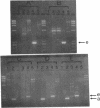Abstract
The complete nucleotide sequences of the luxA to luxE genes, as well as the flanking regions, were determined for the lux operons of two Xenorhabdus luminescens strains isolated from insects and humans. The nucleotide sequences of the corresponding lux genes (luxCDABE) were 85 to 90% identical but completely diverged 350 bp upstream of the first lux gene (luxC) and immediately downstream of the last lux gene (luxE). These results show that the luxG gene found immediately downstream of luxE in luminescent marine bacteria is missing at this location in terrestrial bacteria and raise the possibility that the lux operons are at different positions in the genomes of the X. luminescens strains. Four enteric repetitive intergenic consensus (ERIC) or intergenic repetitive unit (IRU) sequences of 126 bp were identified in the 7.7-kbp DNA fragment from the X.luminescens strain isolated from humans, providing the first example of multiple ERIC structures in the same operon including two ERIC structures at the same site. Only a single ERIC structure between luxB and luxE is present in the 7-kbp lux DNA from insects. Analysis of the genomic DNAs from five X. luminescens strains or isolates by polymerase chain reaction has demonstrated that an ERIC structure is between luxB and luxE in all of the strains, whereas only the strains isolated from humans had an ERIC structure between luxD and luxA. The results indicate that there has been insertion and/or deletion of multiple 126-bp repetitive elements in the lux operons of X.luminescens during evolution.
Full text
PDF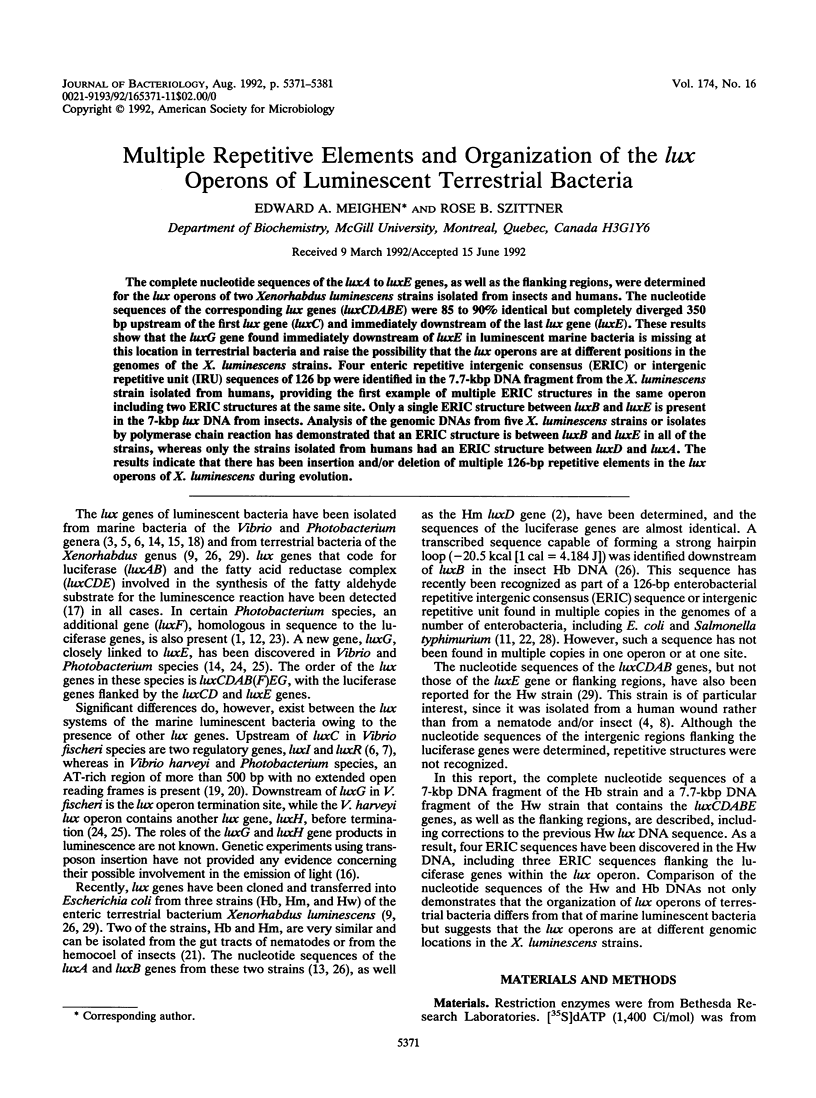
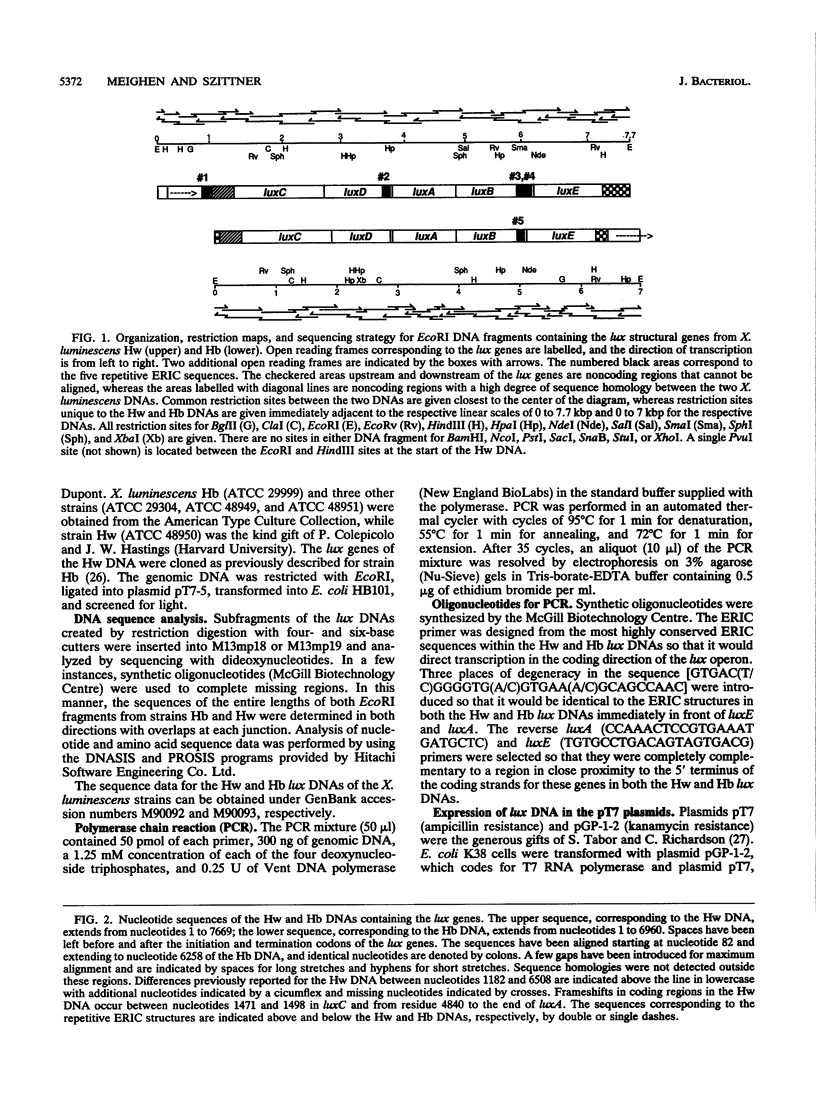
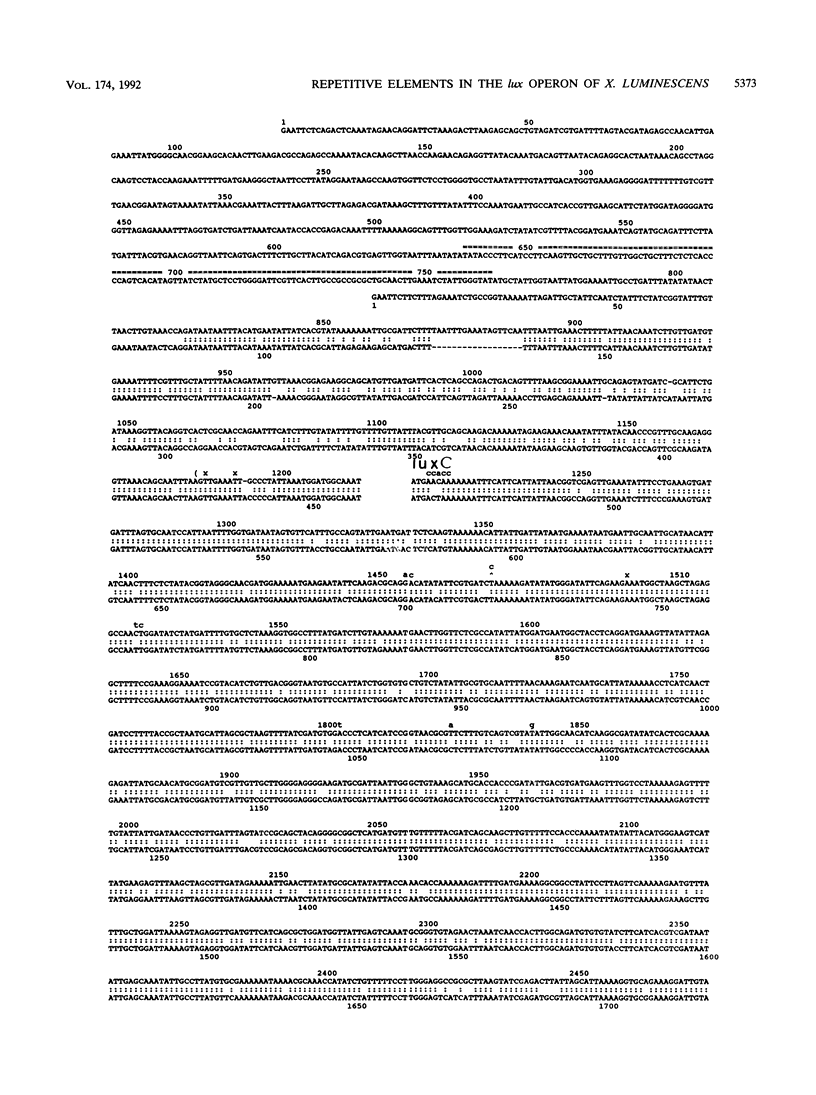
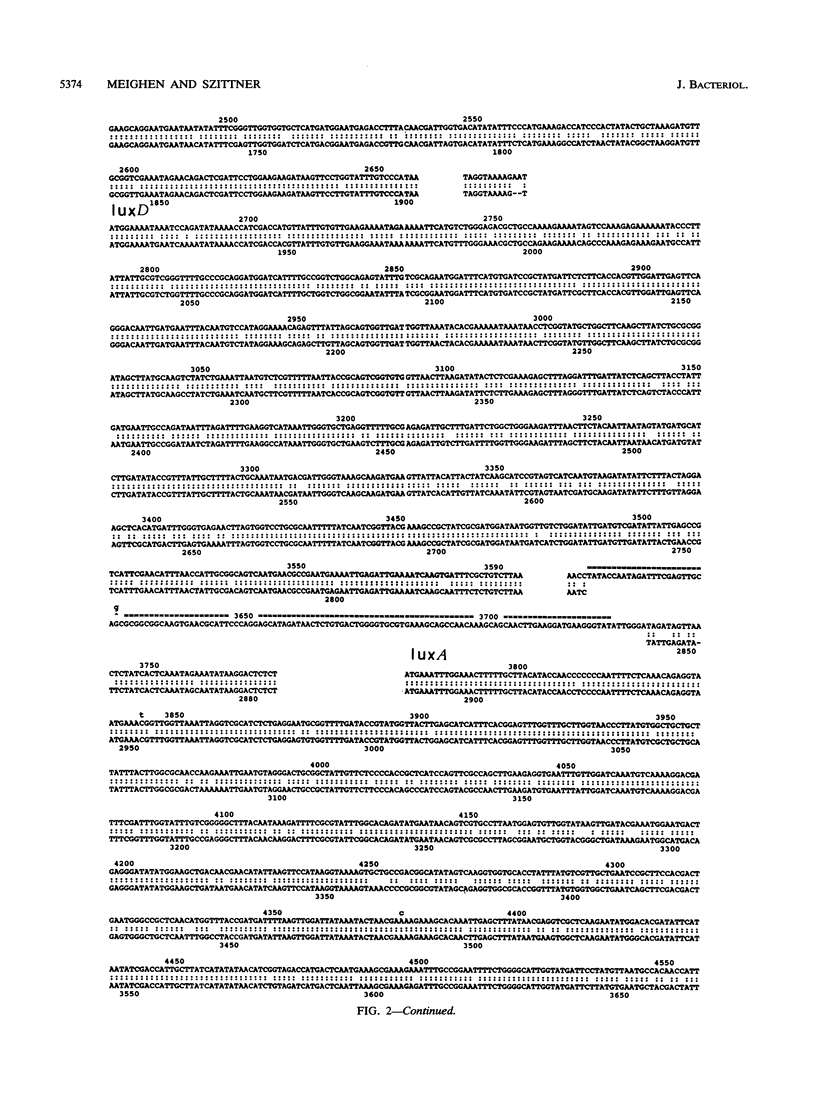
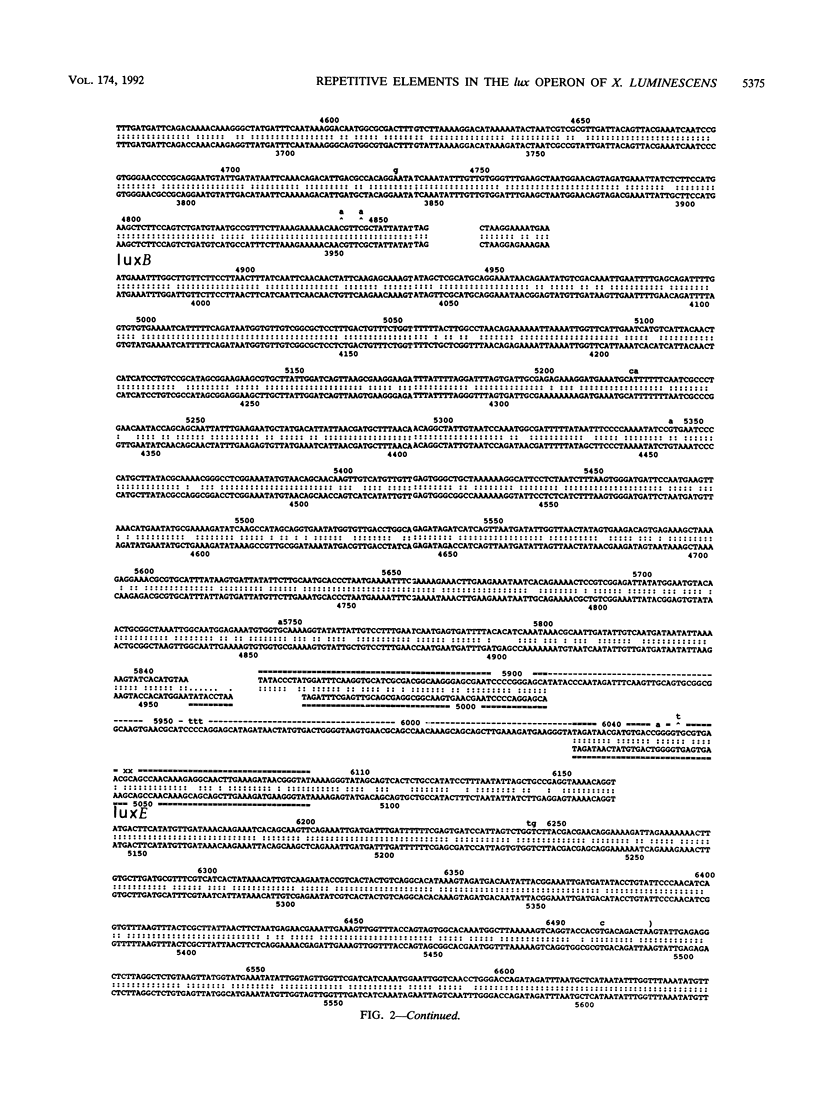
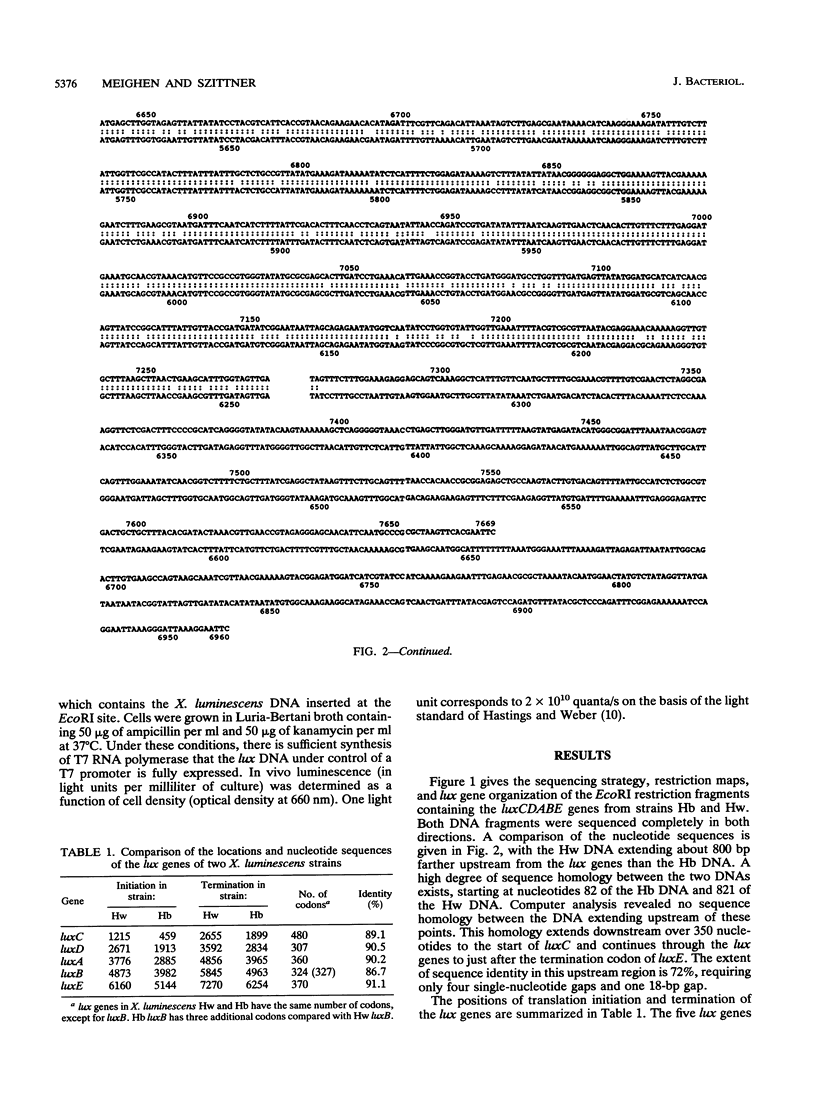

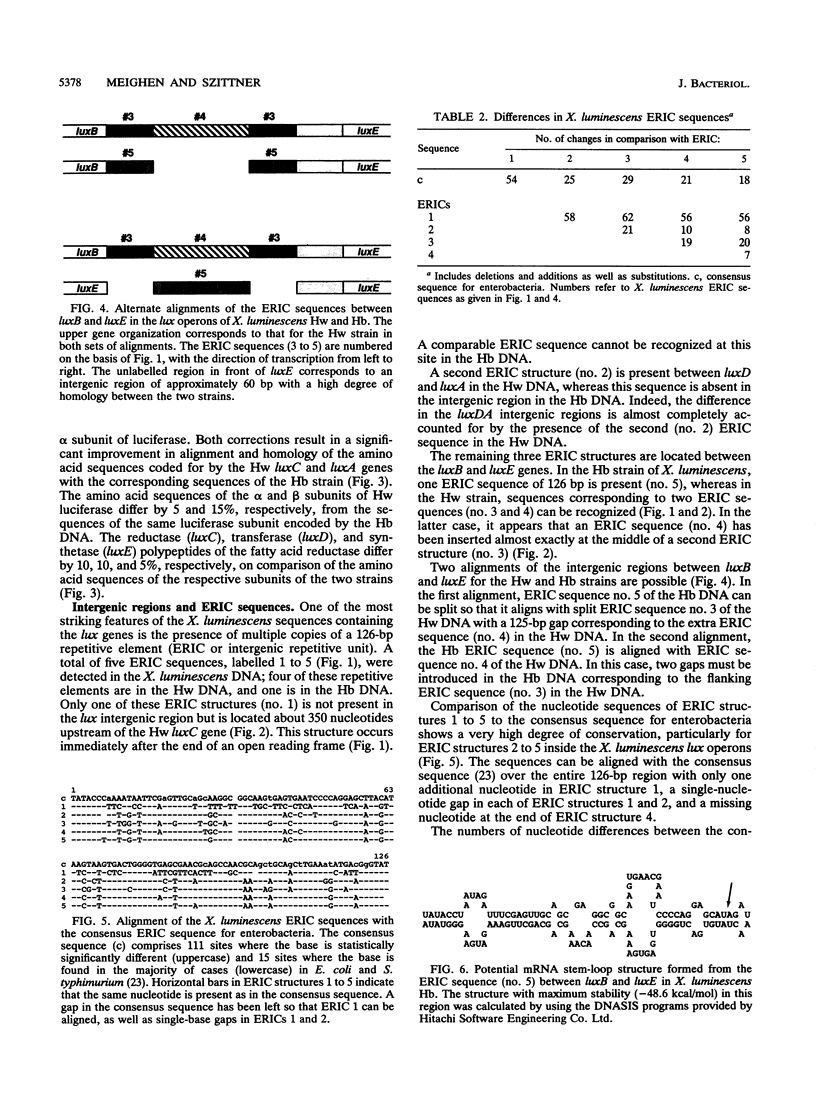
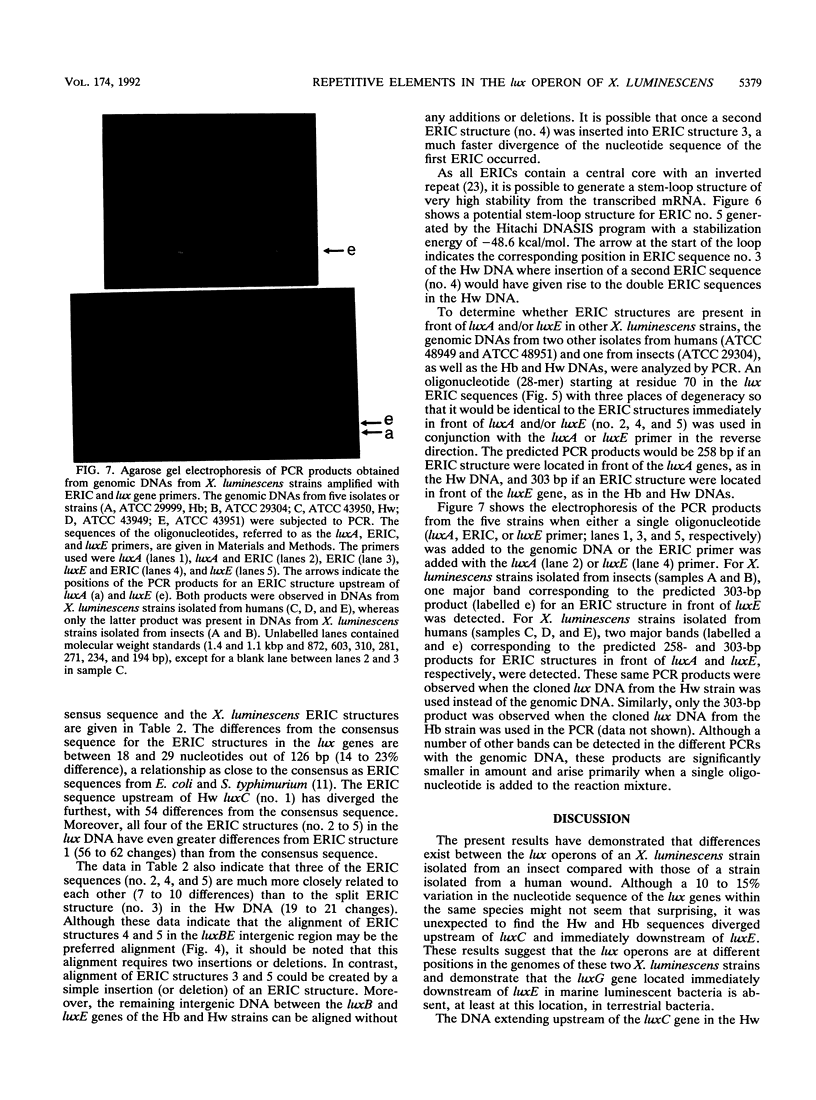
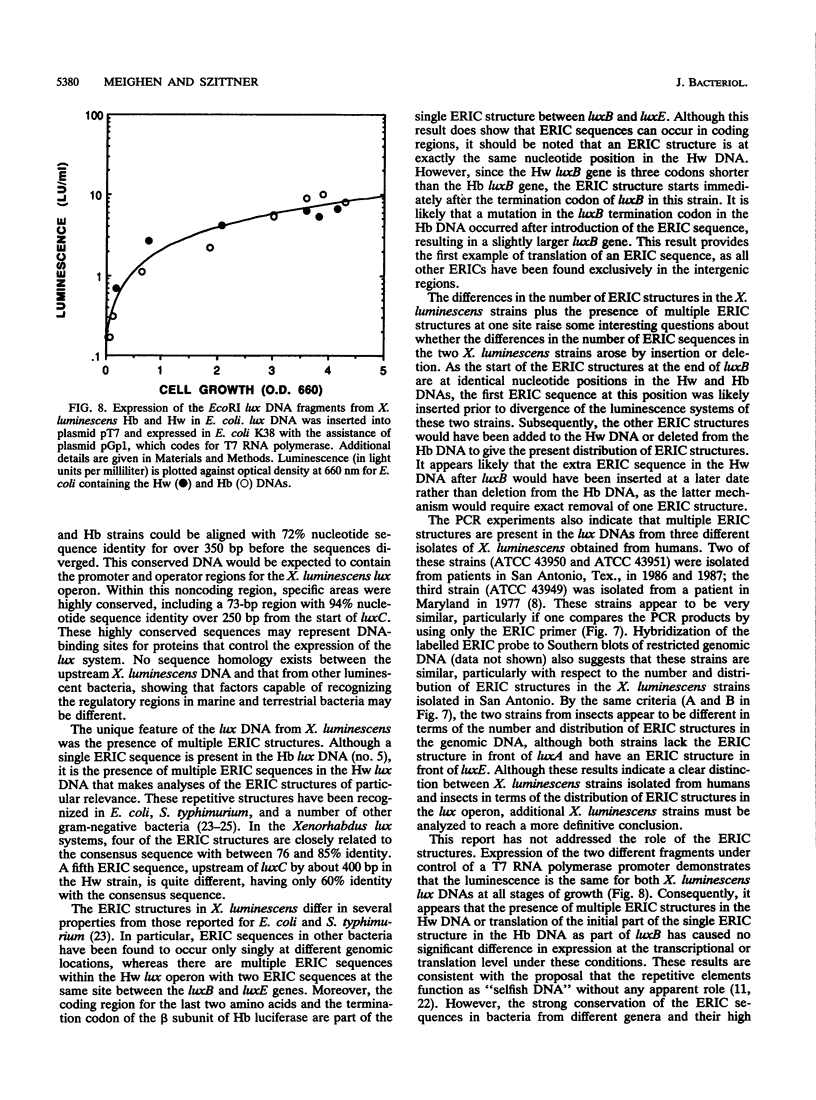
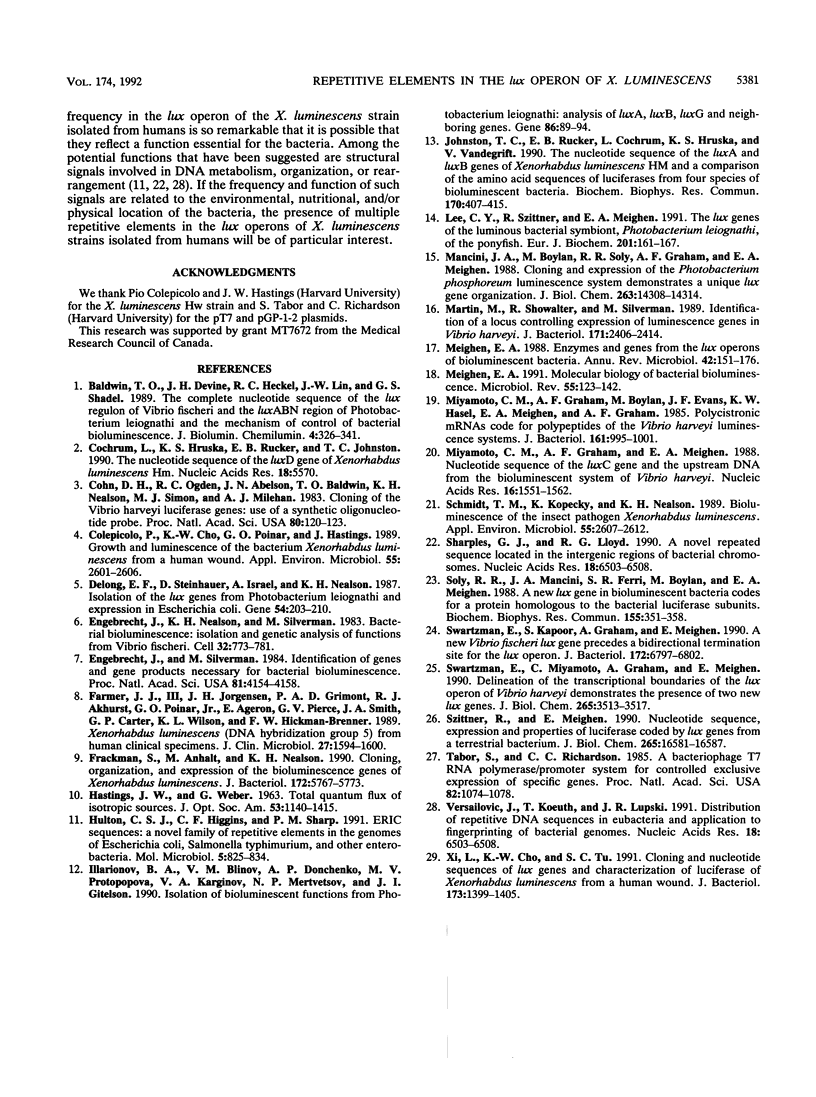
Images in this article
Selected References
These references are in PubMed. This may not be the complete list of references from this article.
- Baldwin T. O., Devine J. H., Heckel R. C., Lin J. W., Shadel G. S. The complete nucleotide sequence of the lux regulon of Vibrio fischeri and the luxABN region of Photobacterium leiognathi and the mechanism of control of bacterial bioluminescence. J Biolumin Chemilumin. 1989 Jul;4(1):326–341. doi: 10.1002/bio.1170040145. [DOI] [PubMed] [Google Scholar]
- Cochrum L., Hruska K. S., Rucker E. B., Johnston T. C. The nucleotide sequence of the luxD gene of Xenorhabdus luminescens Hm. Nucleic Acids Res. 1990 Sep 25;18(18):5570–5570. doi: 10.1093/nar/18.18.5570. [DOI] [PMC free article] [PubMed] [Google Scholar]
- Cohn D. H., Ogden R. C., Abelson J. N., Baldwin T. O., Nealson K. H., Simon M. I., Mileham A. J. Cloning of the Vibrio harveyi luciferase genes: use of a synthetic oligonucleotide probe. Proc Natl Acad Sci U S A. 1983 Jan;80(1):120–123. doi: 10.1073/pnas.80.1.120. [DOI] [PMC free article] [PubMed] [Google Scholar]
- Colepicolo P., Cho K. W., Poinar G. O., Hastings J. W. Growth and luminescence of the bacterium Xenorhabdus luminescens from a human wound. Appl Environ Microbiol. 1989 Oct;55(10):2601–2606. doi: 10.1128/aem.55.10.2601-2606.1989. [DOI] [PMC free article] [PubMed] [Google Scholar]
- Delong E. F., Steinhauer D., Israel A., Nealson K. H. Isolation of the lux genes from Photobacterium leiognathi and expression in Escherichia coli. Gene. 1987;54(2-3):203–210. doi: 10.1016/0378-1119(87)90488-4. [DOI] [PubMed] [Google Scholar]
- Engebrecht J., Nealson K., Silverman M. Bacterial bioluminescence: isolation and genetic analysis of functions from Vibrio fischeri. Cell. 1983 Mar;32(3):773–781. doi: 10.1016/0092-8674(83)90063-6. [DOI] [PubMed] [Google Scholar]
- Engebrecht J., Silverman M. Identification of genes and gene products necessary for bacterial bioluminescence. Proc Natl Acad Sci U S A. 1984 Jul;81(13):4154–4158. doi: 10.1073/pnas.81.13.4154. [DOI] [PMC free article] [PubMed] [Google Scholar]
- Farmer J. J., 3rd, Jorgensen J. H., Grimont P. A., Akhurst R. J., Poinar G. O., Jr, Ageron E., Pierce G. V., Smith J. A., Carter G. P., Wilson K. L. Xenorhabdus luminescens (DNA hybridization group 5) from human clinical specimens. J Clin Microbiol. 1989 Jul;27(7):1594–1600. doi: 10.1128/jcm.27.7.1594-1600.1989. [DOI] [PMC free article] [PubMed] [Google Scholar]
- Frackman S., Anhalt M., Nealson K. H. Cloning, organization, and expression of the bioluminescence genes of Xenorhabdus luminescens. J Bacteriol. 1990 Oct;172(10):5767–5773. doi: 10.1128/jb.172.10.5767-5773.1990. [DOI] [PMC free article] [PubMed] [Google Scholar]
- Hulton C. S., Higgins C. F., Sharp P. M. ERIC sequences: a novel family of repetitive elements in the genomes of Escherichia coli, Salmonella typhimurium and other enterobacteria. Mol Microbiol. 1991 Apr;5(4):825–834. doi: 10.1111/j.1365-2958.1991.tb00755.x. [DOI] [PubMed] [Google Scholar]
- Illarionov B. A., Blinov V. M., Donchenko A. P., Protopopova M. V., Karginov V. A., Mertvetsov N. P., Gitelson J. I. Isolation of bioluminescent functions from Photobacterium leiognathi: analysis of luxA, luxB, luxG and neighboring genes. Gene. 1990 Jan 31;86(1):89–94. doi: 10.1016/0378-1119(90)90117-a. [DOI] [PubMed] [Google Scholar]
- Johnston T. C., Rucker E. B., Cochrum L., Hruska K. S., Vandegrift V. The nucleotide sequence of the luxA and luxB genes of Xenorhabdus luminescens HM and a comparison of the amino acid sequences of luciferases from four species of bioluminescent bacteria. Biochem Biophys Res Commun. 1990 Jul 31;170(2):407–415. doi: 10.1016/0006-291x(90)92106-a. [DOI] [PubMed] [Google Scholar]
- Lee C. Y., Szittner R. B., Meighen E. A. The lux genes of the luminous bacterial symbiont, Photobacterium leiognathi, of the ponyfish. Nucleotide sequence, difference in gene organization, and high expression in mutant Escherichia coli. Eur J Biochem. 1991 Oct 1;201(1):161–167. doi: 10.1111/j.1432-1033.1991.tb16269.x. [DOI] [PubMed] [Google Scholar]
- Mancini J. A., Boylan M., Soly R. R., Graham A. F., Meighen E. A. Cloning and expression of the Photobacterium phosphoreum luminescence system demonstrates a unique lux gene organization. J Biol Chem. 1988 Oct 5;263(28):14308–14314. [PubMed] [Google Scholar]
- Martin M., Showalter R., Silverman M. Identification of a locus controlling expression of luminescence genes in Vibrio harveyi. J Bacteriol. 1989 May;171(5):2406–2414. doi: 10.1128/jb.171.5.2406-2414.1989. [DOI] [PMC free article] [PubMed] [Google Scholar]
- Meighen E. A. Molecular biology of bacterial bioluminescence. Microbiol Rev. 1991 Mar;55(1):123–142. doi: 10.1128/mr.55.1.123-142.1991. [DOI] [PMC free article] [PubMed] [Google Scholar]
- Miyamoto C. M., Graham A. D., Boylan M., Evans J. F., Hasel K. W., Meighen E. A., Graham A. F. Polycistronic mRNAs code for polypeptides of the Vibrio harveyi luminescence system. J Bacteriol. 1985 Mar;161(3):995–1001. doi: 10.1128/jb.161.3.995-1001.1985. [DOI] [PMC free article] [PubMed] [Google Scholar]
- Miyamoto C. M., Graham A. F., Meighen E. A. Nucleotide sequence of the LuxC gene and the upstream DNA from the bioluminescent system of Vibrio harveyi. Nucleic Acids Res. 1988 Feb 25;16(4):1551–1562. doi: 10.1093/nar/16.4.1551. [DOI] [PMC free article] [PubMed] [Google Scholar]
- Schmidt T. M., Kopecky K., Nealson K. H. Bioluminescence of the insect pathogen Xenorhabdus luminescens. Appl Environ Microbiol. 1989 Oct;55(10):2607–2612. doi: 10.1128/aem.55.10.2607-2612.1989. [DOI] [PMC free article] [PubMed] [Google Scholar]
- Sharples G. J., Lloyd R. G. A novel repeated DNA sequence located in the intergenic regions of bacterial chromosomes. Nucleic Acids Res. 1990 Nov 25;18(22):6503–6508. doi: 10.1093/nar/18.22.6503. [DOI] [PMC free article] [PubMed] [Google Scholar]
- Soly R. R., Mancini J. A., Ferri S. R., Boylan M., Meighen E. A. A new lux gene in bioluminescent bacteria codes for a protein homologous to the bacterial luciferase subunits. Biochem Biophys Res Commun. 1988 Aug 30;155(1):351–358. doi: 10.1016/s0006-291x(88)81092-1. [DOI] [PubMed] [Google Scholar]
- Swartzman A., Kapoor S., Graham A. F., Meighen E. A. A new Vibrio fischeri lux gene precedes a bidirectional termination site for the lux operon. J Bacteriol. 1990 Dec;172(12):6797–6802. doi: 10.1128/jb.172.12.6797-6802.1990. [DOI] [PMC free article] [PubMed] [Google Scholar]
- Swartzman E., Miyamoto C., Graham A., Meighen E. Delineation of the transcriptional boundaries of the lux operon of Vibrio harveyi demonstrates the presence of two new lux genes. J Biol Chem. 1990 Feb 25;265(6):3513–3517. [PubMed] [Google Scholar]
- Szittner R., Meighen E. Nucleotide sequence, expression, and properties of luciferase coded by lux genes from a terrestrial bacterium. J Biol Chem. 1990 Sep 25;265(27):16581–16587. [PubMed] [Google Scholar]
- Tabor S., Richardson C. C. A bacteriophage T7 RNA polymerase/promoter system for controlled exclusive expression of specific genes. Proc Natl Acad Sci U S A. 1985 Feb;82(4):1074–1078. doi: 10.1073/pnas.82.4.1074. [DOI] [PMC free article] [PubMed] [Google Scholar]
- Xi L., Cho K. W., Tu S. C. Cloning and nucleotide sequences of lux genes and characterization of luciferase of Xenorhabdus luminescens from a human wound. J Bacteriol. 1991 Feb;173(4):1399–1405. doi: 10.1128/jb.173.4.1399-1405.1991. [DOI] [PMC free article] [PubMed] [Google Scholar]



